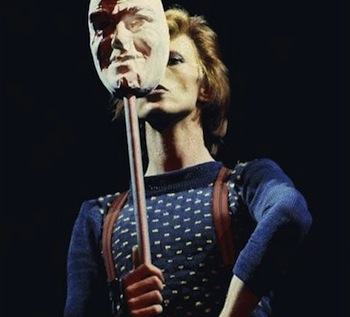As an artist, David Bowie has spent a lifetime blurring the lines between performer and stage persona: after all, The Rise and Fall of Ziggy Stardust and the Spiders From Mars was famously advertised with the slogan “David Bowie is Ziggy Stardust”—while, in smaller type, the words “Ziggy Stardust is David Bowie” ran across the bottom of the ad.
This confusion between creator and creation is something Bowie has played upon from the very beginning—and then there’s the fact that, over the last couple decades, he himself has become the direct inspiration for various fictional characters, from the Lucifer of Neil Gaiman’s Sandman to The Venture Bros. shapeshifting leader of The Guild of Calamitous Intent. So let’s take a look at a few of Bowie’s more interesting incarnations, both as an actor and as a character, the dreamer and the dream, beginning with his acting debut in the unsettling 1967 short film The Image.
Filmed in black and white and featuring minimalist soundtrack and no dialogue, The Image follows a young Michael Byrne as a painter haunted by his own beautiful, otherworldly creation. In the role of the image-sprung-to-life, Bowie’s interest and training in mime and avant-garde performance art, which would inform his later musical alter egos, are much in evidence here. Furthermore, the troubled relationship between The Artist and The Image that takes on a life of his own seems rather prophetic when viewed in light of later episodes in Bowie’s career—his abrupt killing-off of Ziggy at the height of the character’s popularity, for example, or his drug-fueled Thin White Duke phase, which devolved into deranged incoherence and eventual breakdown; Bowie later blamed his behavior and mental instability at the time on both his cocaine addiction and the malignant nature of the character he’d created.
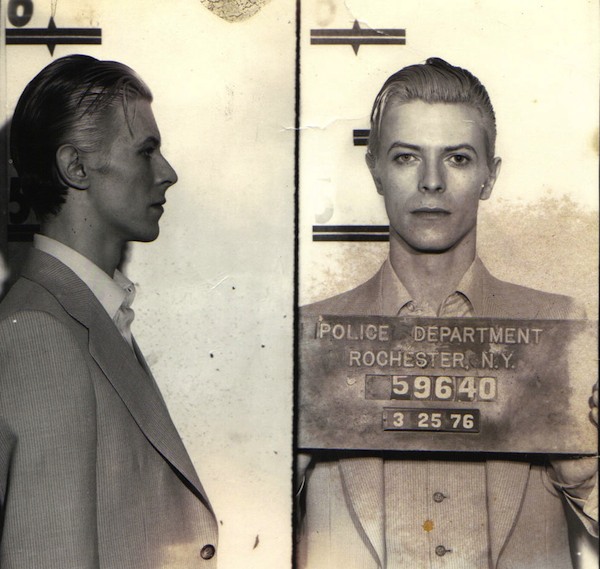
While The Image is sometimes said to be loosely inspired by Oscar Wilde’s The Picture of Dorian Gray, the parallels with the novel are much more obvious in the video for “Look Back in Anger” (1979). This time around, Bowie himself plays both the painter and the subject of the painting, but while the image remains safely on canvas, the artist’s face begins to decay—again, it’s easy to read the video as a comment on his recent struggles, a recognition of both the price of creating art and the potent narcissism involved in the process.
By the mid-eighties, having vanquished his demons and revitalized his career, Bowie was able to have some self-deprecating fun in the goofy, charming Jazzin’ for Blue Jean, a 20-minute promo film which won the 1985 Grammy Award for Best Short Form Music Video. As a likeable doofus named Vic who pretends to be friendly with David Bowie-esque rock star Screamin’ Lord Byron in order to impress a girl, Bowie is endearingly dorky even as he mocks his former reputation for bizarre behavior and rock star excess as the tweaked out Mr. Screamin’.
In the last minutes of the film, the self-spoofery becomes even more elaborate as the “real” Bowie breaks the fourth wall to complain to the director (Julien Temple) that his vision isn’t being respected, further playing with the stereotype of the spoiled star—it’s amusing, and clever (but not clever-clever!), and Bowie clearly has a great time poking fun at the joyless self-indulgence of the pretentious rock star.
A few years later in 1988, Bowie turned in a strong performance in Martin Scorcese’s adaptation of The Last Temptation of Christ in the brief but pivotal role of Pontius Pilate, kicking off a series of memorable supporting parts: FBI Agent Phillip Jeffries in David Lynch’s Twin Peaks: Fire Walk with Me, Andy Warhol in Julian Schnabel’s Basquiat biopic, Tesla in the previously mentioned adaptation of The Prestige, and so on.
He’s also branched out into voice work in the last decade, even famously showing up on SpongeBob SquarePants as Lord Royal Highness, the Blue Meanie-esque ruler of Atlantis. And then, of course, there was his much-loved cameo in Zoolander and his hilarious/painful appearance with Ricky Gervais on Extras—Bowie’s clearly comfortable playing serious, silly, or self-mocking, which might explain why he’s become so popular with other creators over the years—beginning with one Mr. Neil Gaiman.
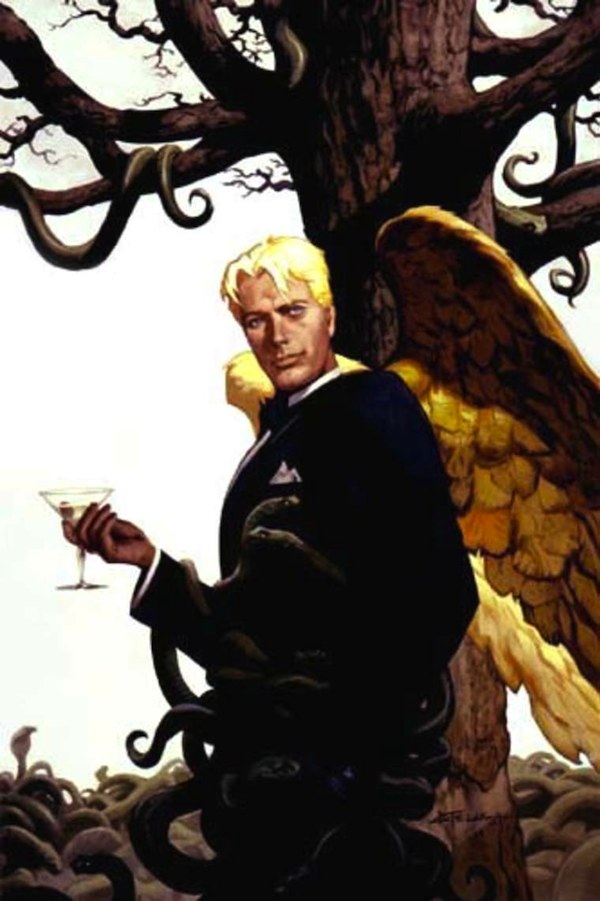
When Gaiman reimagined Lucifer while writing Sandman, he was extremely adamant that the ruler of Hell resemble David Bowie as closely as possible. According to artist Kelley Jones, Gaiman insisted, “You must draw David Bowie. Find David Bowie, or I’ll send you David Bowie. Because if it isn’t David Bowie, you’re going to have to redo it until it is David Bowie.” The artists complied, and the resulting character ranks as the greatest depiction of His Infernal Majesty since Milton (and/or Peter Cooke in Bedazzled), at least for my money. Gaiman’s also been quoted as saying that David Bowie would make the perfect Joker (although he’s not alone in endorsing the Joker/Bowie connection, by any means, and Grant Morrison has admitted to using late-70s Bowie as a model for his own take on the character).
Gaiman has also collaborated with artist Yoshitako Amano (most known for his work on the Final Fantasy series) on an unreleased story called “The Return of the Thin White Duke;” a sort of prologue was published in V magazine in 2004. The story apparently revolves around Bowie and his wife Iman living in a fantasy version of New York, in which she is the queen and he comes to find her after 1000 years; although the current status of that project is unknown, you can still check out glimpses of Amano’s fabulous artwork online.
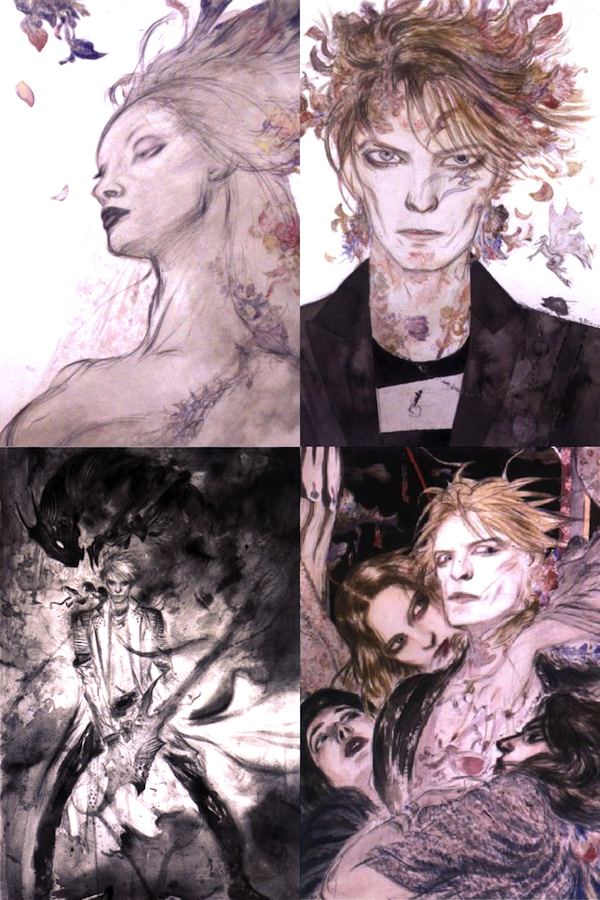
And finally, while we’re on the topic of Gaiman’s love of Bowie, I’d be remiss if I didn’t include his DIY remake of Labyrinth, starring Amanda Palmer, himself, some sock puppets, a glorious wig, a silver cape, and pure genius—imitation is the highest form of flattery, of course—and when awesome people choose to imitate David Bowie, everybody wins:
Of course, Gaiman wasn’t the first to succumb to the sparkly lure of Bowie Impersonation, and he won’t be the last. We’ll be discussing Todd Haynes’ quasi-biopic (but not quite, for legal reasons) Velvet Goldmine in a separate post, but if you’ve seen it, you already know all you need to know about glam-inspired costume porn and Jonathan Rhys-Meyers: Faux Bowie extraordinaire. Then there’s Castor, Michael Sheen’s character in TRON: Legacy, who Sheen claimed was inspired by Bowie and The Rocky Horror Picture Show with a touch of Mae West. Huh. The look, however, is pure Bowie (making it one of the best things about the film, for better or worse).
The epic “Bowie” episode of Flight of the Conchords clearly deserves a mention here, both because of Jemaine Clement’s incredibly entertaining Bowie impression and the climactic fantasy sequence set to the song “Bowie” (aka “Bowie’s in Space”), which packs in enough visual and musical references to his career that even the most hardcore Bowie fan will be impressed. It certainly doesn’t hurt that the song is hilarious, and ridiculously catchy to boot—an irreverent love letter to the sheer outlandish awesomeness of Bowie’s entire career:
Last, but certainly not least, I have to give a shoutout to The Venture Bros., and their creators’ abiding love for all things David Bowie. The references to his work in the series are too numerous to list, although I highly recommend the Season 1 episode “Ghosts of the Sargasso” as a standout—half of the episode is spent in an extended “Ashes to Ashes”-inspired gag, with plenty of random references to other Bowie songs and lyrics for good measure, and all of it is brilliant. But even with their Bowie fanboy status clearly established early on, I doubt anybody saw it coming when Bowie was revealed to be the mysterious Sovereign, leader of The Guild of Calamitous Intent—except that it makes perfect sense, in terms the show’s warped logic.
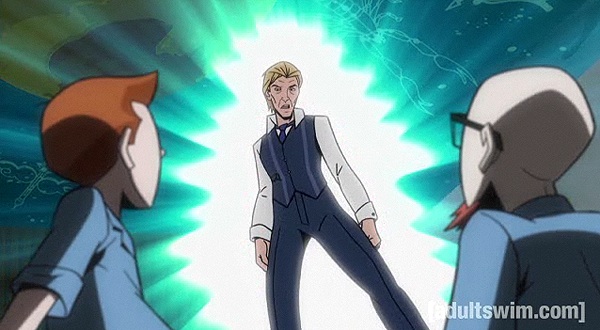
In a series that tends to revel in obscure 70s and 80s art, music, and pop culture references, clearly the person in charge should be someone who’s remained unquestionably hip and culturally relevant throughout: for Doc Hammer and Jackson Publick, that person is obviously David Bowie. Even as a supervillain, Bowie is polite, charming, and insanely cool—the apotheosis of hip combined with a humanizing penchant for self-mockery.
It’s a fitting tribute to a performer who’s toyed with the boundaries between personal identity, public image, fictional personas and “real life,” throughout his career that he continues to inspire these various homages, whether serious or silly. He’s become something very rare: an approachable icon, whose public image is fluid enough to resist simple parody—after all, no one enjoys making fun of being David Bowie more than David Bowie does. It’s all part of why he’s awesome, so here’s to many more years and many more versions of Bowie: the real, the unreal, and everything in between.
This article was originally published on January 10, 2012 as part of Bowie Week.
Bridget McGovern did her best to work in a reference to Bowie’s 37-second appearance in Yellowbeard with Madeline Kahn and Eric Idol, but this post was already long enough…










